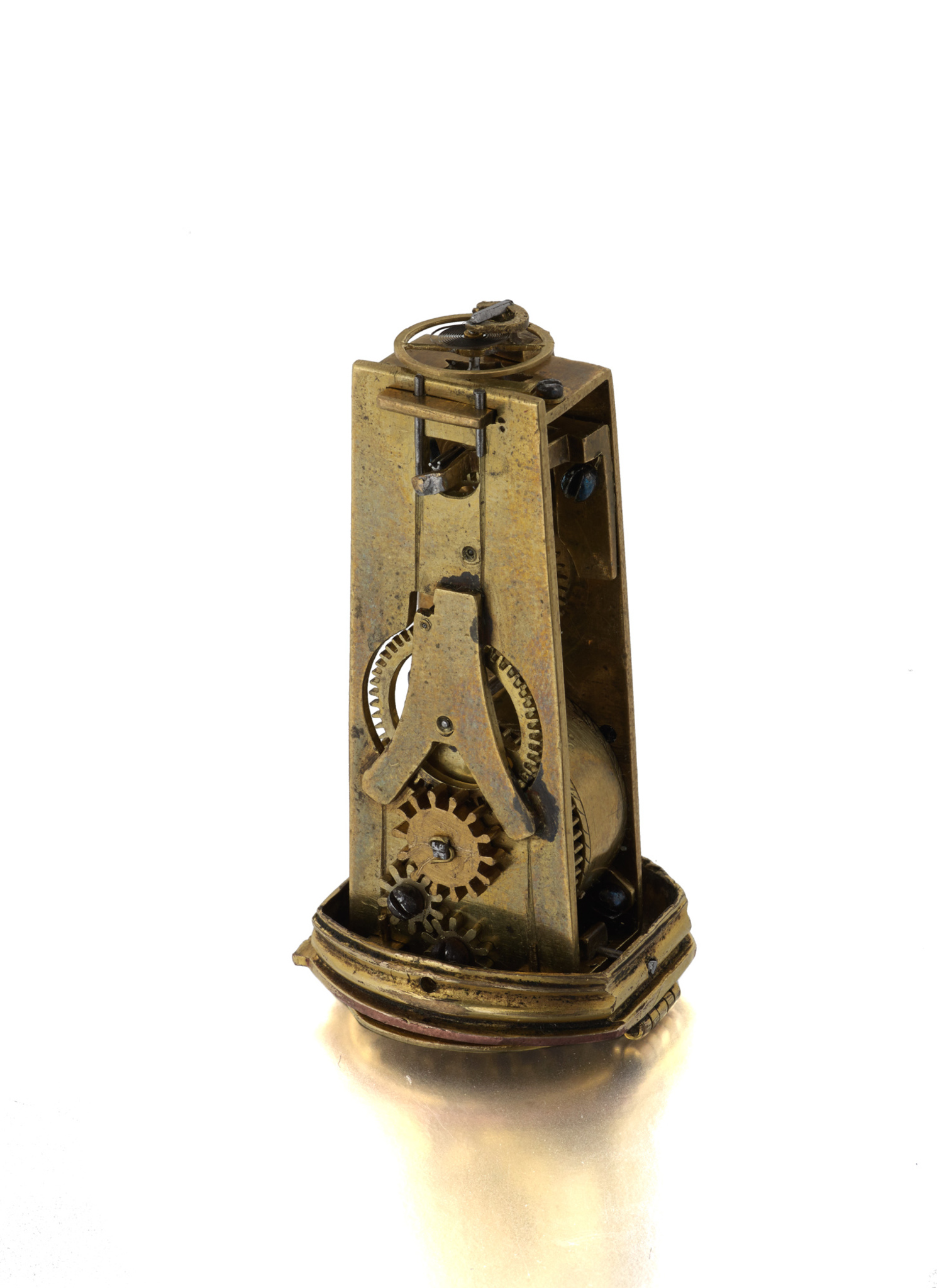Notes
Once the knife is placed in its case, we observe that there is a little space left in the upper part of it, probably to put the winding-key. This key must have been attached to the lid which is unfortunately lost today. The remaining part of the case is covered with burgundy velvet. This watch-object, dating from the early 17th century, is the only one of its kind known to date. We have found no mention of such an object in the literature, either in watchmaking or cutlery. On the other hand, one is naturally reminded of an archival text ?? often quoted in books on the history of watchmaking ?? about two daggers incorporating watches in their pommels: “Mandement à Jean Sapin, receveur général de Languedoil et Guyenne, de payer à Julien Couldray horloger à Blois la somme de 200 écus d’or soleil pour son payement de deux dagues excellantes garnies dedans les pommeaux de deux orloges toutes dorées et destinées à l’usage du roi.” (Mandate to Jean Sapin, Receiver General of Languedoil and Guyenne, to pay to Julien Couldray, clockmaker in Blois, the sum of 200 gold “écus au soleil” for his payment of two excellent daggers incorporating in their pommels two gilded clocks for the king’s use.) It is through this extract from the account books of François I (1494- 1547), King of France (1515-1547), dated December 31, 1518, that we know of the existence of the first portable timepieces made in France. Julien Couldray (or Coudray) from Blois is already “Horloger du Roy”, previously active in the service of Louis XII (1462-1515), King of France (1498-1515). Louis XII, who was both the cousin and father-in-law of François I, chose to establish his ordinary residence in Blois, his birthplace, which led to the establishment of the Court in this town, then to the influence of the Loire Valley in the 16th century. These two daggers are now lost (Paris, Archives Nationales, KK 289, f° 444). Note that a dagger is a large knife, therefore much larger than our object. The only other known ancient objects related to ours are: • A watch mounted in the pommel of a sword, unsigned work of German manufacture, before 1600 (Dresden, Grünes Gewölbe). • A folding knife incorporating a watch in its handle, unsigned work of German manufacture, circa 1690. Antiquorum, Geneva, auction, October 21, 1995, lot 849 (Estimate: CHF 90 000.- / 100 000.-). https://catalog.antiquorum.swiss/en/lots/lot-115-849?browse_ all=1&page=4&q=knife Antiquorum, Geneva, auction, April 13, 2002, lot 42, sold for the amount of CHF 212 500.- (Estimate: CHF 150 000.- / 170 000.-). • https://catalog.antiquorum.swiss/en/lots/lot-26-42?browse_ all=1&page=3&q=knife It is then necessary to wait until the beginning of the 19th century to find this type of object. It is in Geneva that one encounters a production of small gold knives, richly decorated with enamel and / or pearls, sometimes incorporating a watch and / or a miniature music mechanism with vibrating blades. This production is often attributed to the Piguet & Capt workshop, which specialises in the construction of prestige and fantasy objects, often destined for export markets such as China. These luxurious knives can be fitted with one or two blades. In the latter case, the steel blade is used to pick a fruit, while the gold blade is used to peel it without oxidizing it. About ten of these knives are now listed, some of which are kept in the Patek Philippe Museum in Geneva. Geneva, circa 1810 https://catalog.antiquorum.swiss/en/lots/lot-115-911?browse_ all=1&page=4&q=knife+watch https://catalog.antiquorum.swiss/en/lots/lot-54-97?browse_ all=1&page=3&q=knife+watch https://catalog.antiquorum.swiss/en/lots/lot-14-177?browse_ all=1&page=3&q=knife+watch https://www.sothebys.com/en/auctions/ecatalogue/2018/importantwatches- ge1801/lot.200.html?locale=en During the Art Deco period, creators such as Louis Cartier (1875-1942) embedded watch movements in letter openers. The idea was taken up by Patek Philippe in the 1980’s, with his “Ellipse” watch letter opener (Ref. 913, quartz movement), then, in the year 2000, by Cartier with a limited and numbered series of 2 000 watch letter openers (quartz movement). Nowadays, the Victorinox brand sells a “Swiss Army Knife” with a watch: the “TimeKeeper”. Cartier, circa 1930 https://catalog.antiquorum.swiss/en/lots/cartier-lot-126-286?browse_ all=1&page=4&q=knife+watch Patek Philippe, Ref. 913, circa 1980-1985 https://catalog.antiquorum.swiss/en/lots/patek-philippe-ref-ref-913-lot- 216-462?browse_all=1&page=2&q=knife+watch https://catalog.antiquorum.swiss/en/lots/patek-philippe-ref-ref-913-lot- 148-176?browse_all=1&page=3&q=knife+watch Cartier, limited edition, 2000 https://catalog.antiquorum.swiss/en/lots/cartier-lot-257-161?browse_ all=1&page=2&q=knife+watch https://catalog.antiquorum.swiss/en/lots/cartier-lot-249-19?browse_ all=1&page=2&q=knife+watch




